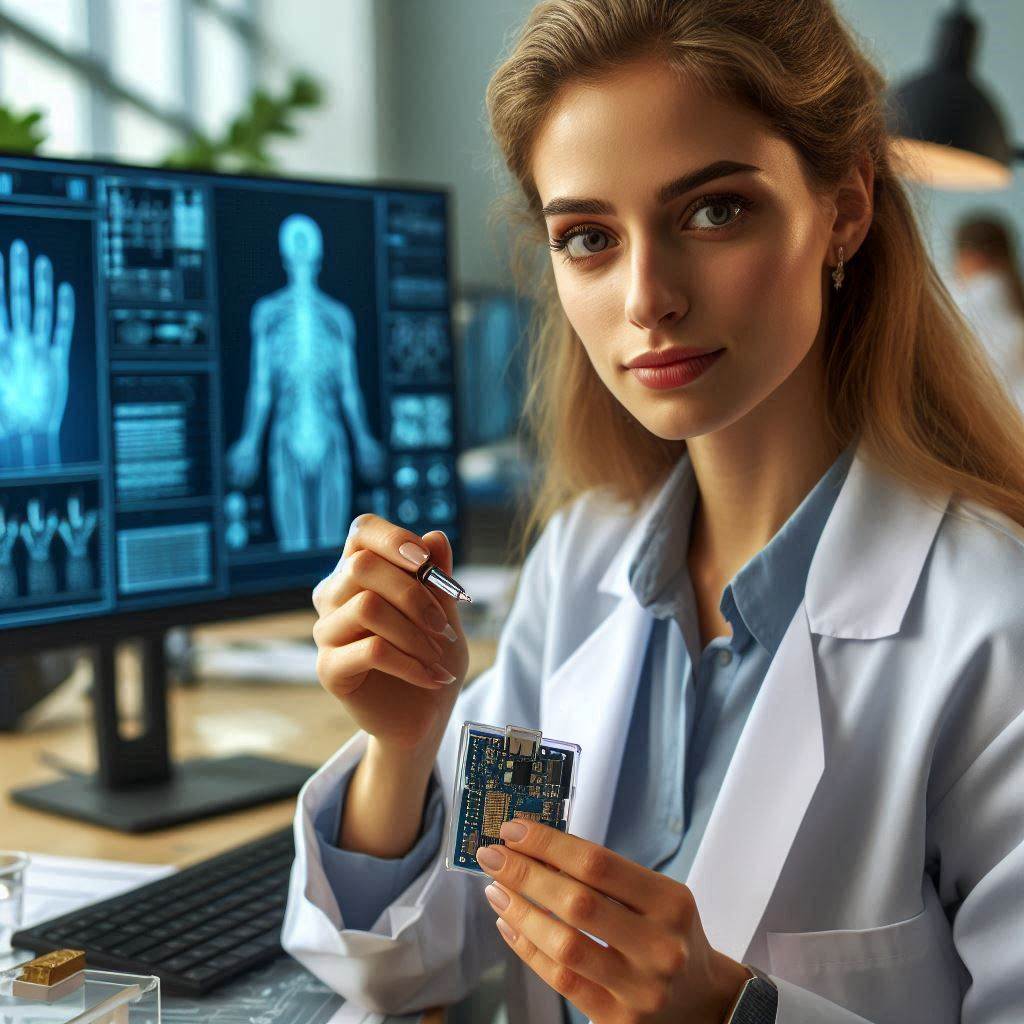Introduction
Biomedical engineering merges engineering principles with medical and biological sciences, leading to groundbreaking innovations in healthcare.
This interdisciplinary field addresses complex medical challenges and creates technologies that significantly improve patient care.
What is Biomedical Engineering?
Biomedical engineering is a specialized branch that integrates engineering techniques with medical and biological knowledge.
It focuses on designing and developing medical devices, diagnostic imaging systems, and rehabilitation technologies.
Importance in Healthcare
Biomedical engineers contribute to healthcare by improving diagnostic accuracy through advanced imaging technologies, such as MRI and CT scans.
They also enhance treatment options with the development of sophisticated surgical tools and implantable devices.
Thesis Statement
Biomedical engineering has a profound impact on public health by reducing the burden of disease through the development of advanced medical devices and diagnostic tools.
It enhances the quality of life with innovative treatments and therapies, and it expands access to healthcare through cutting-edge technologies that make medical care more accessible and effective.
Overview of Biomedical Engineering
Biomedical engineering combines principles from engineering and biological sciences.
It aims to improve healthcare through innovative solutions.
This field addresses complex medical challenges with a focus on enhancing patient care.
Definition of Biomedical Engineering
Biomedical engineering applies engineering principles to medicine and biology.
It involves designing and developing medical devices, systems, and technologies.
Engineers in this field work to create solutions that improve health outcomes and patient quality of life.
Various Applications in Healthcare
Biomedical engineering impacts healthcare in several significant ways:
- Medical Devices: Engineers design devices like pacemakers, artificial limbs, and imaging systems. These devices improve diagnosis and treatment.
- Diagnostic Tools: Innovations include advanced imaging techniques such as MRI and CT scans. These tools enhance early detection and accurate diagnosis of diseases.
- Prosthetics and Orthotics: Engineers develop custom prosthetic limbs and orthotic devices. These support mobility and functionality for individuals with disabilities.
- Biomaterials: Research in biomaterials leads to the creation of materials used in implants and tissue engineering. These materials are biocompatible and aid in body repair.
- Healthcare IT: Biomedical engineers develop software and systems for managing patient information and improving clinical workflows. These systems enhance efficiency and patient care.
Contribution to Medical Advancements
Biomedical engineering drives numerous advancements in medicine:
- Enhanced Treatment Methods: The field has led to the development of minimally invasive surgical techniques. These methods reduce recovery times and improve patient outcomes.
- Innovative Therapies: Engineers contribute to the creation of targeted therapies and personalized medicine. These approaches cater to individual patient needs and improve treatment effectiveness.
- Improved Patient Monitoring: Wearable technology and remote monitoring systems enable real-time health tracking. These innovations help in managing chronic conditions and preventing complications.
- Advancements in Rehabilitation: Modern rehabilitation technologies, including robotic exoskeletons and virtual reality systems, aid in physical therapy and recovery.
- Progress in Regenerative Medicine: Biomedical engineers are at the forefront of developing tissue engineering and stem cell research. These efforts aim to repair or replace damaged tissues and organs.
Biomedical engineering represents a dynamic and evolving field with a profound impact on public health.
Its innovations not only enhance medical practice but also improve patient lives across the globe.
Development of Medical Devices
Creation of Innovative Devices
Biomedical engineers focus on creating devices that address pressing health issues. These innovations include:
- Diagnostic Tools: Advanced imaging systems, such as MRI and CT scanners, offer detailed internal views, aiding in accurate diagnosis.
- Treatment Devices: Modern pacemakers and insulin pumps help manage chronic conditions effectively, improving patient management.
- Surgical Instruments: Robotics and minimally invasive tools reduce recovery times and surgical risks, enhancing precision in operations.
- Wearable Health Monitors: Devices like smartwatches and fitness trackers provide continuous health monitoring, promoting proactive care.
Examples of Successful Medical Devices
Several medical devices have made significant impacts on patient care:
- Heart Pacemakers: These devices regulate heartbeats, enabling patients with arrhythmias to live active lives.
- Insulin Pumps: They offer continuous insulin delivery, helping diabetic patients maintain stable glucose levels.
- Artificial Limbs: Prosthetic limbs, designed with advanced materials and technology, enhance mobility and functionality for amputees.
- Implantable Defibrillators: These devices detect and correct life-threatening heart rhythms, saving lives in emergencies.
Improvement in Patient Outcomes and Quality of Life
The development of these devices has led to substantial improvements in patient outcomes and quality of life.
Key benefits include:
- Enhanced Diagnostic Accuracy: Innovative diagnostic tools provide precise information, allowing for early detection and treatment of diseases.
- Effective Disease Management: Devices like insulin pumps and pacemakers help manage chronic conditions, reducing hospital visits and improving daily life.
- Reduced Recovery Time: Minimally invasive surgical tools and robotic assistance lead to quicker recovery periods, allowing patients to resume normal activities faster.
- Increased Mobility and Independence: Advanced prosthetics and wearable monitors enhance physical capabilities and provide continuous health insights, promoting independence.
In general, biomedical engineering‘s advancements in medical devices significantly impact public health.
Through innovative diagnostic and treatment tools, engineers are improving patient outcomes and elevating quality of life.
These devices not only address current health challenges but also pave the way for future advancements in medical technology.
Read: Top Cities for Electrical Engineering Jobs in America
Advancements in Imaging Technology
Introduction of Cutting-Edge Imaging Techniques
Recent breakthroughs have introduced several groundbreaking imaging techniques:
- Magnetic Resonance Imaging (MRI) Enhancements: Modern MRI machines provide high-resolution images with greater speed. These enhancements enable more detailed visualization of tissues and organs.
- Positron Emission Tomography (PET) Innovations: New PET scanners offer improved sensitivity and spatial resolution. They allow for better imaging of metabolic processes in the body.
- Computed Tomography (CT) Advances: Latest CT scanners use advanced algorithms for clearer, more precise images. This progress reduces the radiation dose while maintaining image quality.
- Optical Coherence Tomography (OCT): OCT has evolved to provide detailed cross-sectional images of tissues. It is particularly valuable in ophthalmology for diagnosing retinal diseases.
Early Detection of Diseases
Early detection of diseases can significantly improve treatment outcomes.
Advanced imaging techniques play a crucial role in identifying conditions before symptoms arise. Key benefits include:
- Detection of Cancer: Advanced imaging techniques can detect tumors at a much earlier stage. Early identification of cancers like breast, lung, and prostate improves survival rates and treatment effectiveness.
- Cardiovascular Health: Enhanced imaging tools can identify heart disease and related issues before they become severe. This allows for timely intervention and management.
- Neurological Conditions: Innovations in imaging help in the early detection of neurological disorders such as Alzheimer‘s disease and multiple sclerosis. Early diagnosis can slow disease progression and improve quality of life.
Enhanced Accuracy in Medical Diagnosis
The latest imaging technologies offer improved diagnostic accuracy.
This enhanced precision leads to better patient outcomes.
Key improvements include:
- Detailed Imaging: Modern imaging techniques provide high-resolution images that reveal intricate details. This allows for more accurate identification of abnormalities.
- Reduced False Positives: Advanced algorithms and imaging techniques reduce the rate of false positives. This minimizes unnecessary procedures and reduces patient anxiety.
- Enhanced Quantification: New technologies offer precise measurements of tumor size and other critical metrics. Accurate quantification helps in monitoring disease progression and response to treatment.
- Integration with AI: Artificial Intelligence (AI) tools integrate with imaging technologies to analyze data more efficiently. AI algorithms can detect patterns and anomalies that might be missed by human eyes.
Therefore, advancements in imaging technology are transforming public health.
Cutting-edge techniques enable early disease detection and improve diagnostic accuracy.
These innovations not only enhance patient care but also contribute to more effective and timely medical interventions.
Read: US Tech Hubs Beyond Silicon Valley: Emerging Cities
Drug Delivery Systems
Drug delivery systems are revolutionizing public health by enhancing the effectiveness of treatments and minimizing side effects.
Advances in biomedical engineering have paved the way for targeted drug delivery methods.
These innovations are transforming the way we approach disease management and treatment.
Transform Your Career Today
Unlock a personalized career strategy that drives real results. Get tailored advice and a roadmap designed just for you.
Start NowDevelopment of Targeted Drug Delivery Methods
Traditional drug delivery methods often result in systemic exposure, which can lead to unwanted side effects.
New developments in targeted drug delivery aim to address this issue.
These methods focus on delivering medication precisely to the disease site.
This approach increases the drug’s effectiveness while reducing its impact on healthy tissues.
Key developments include
- Nanoparticle Systems: These tiny carriers transport drugs directly to specific cells or tissues.
- Liposome-Based Delivery: Liposomes encapsulate drugs, enhancing their stability and controlling their release.
- Monoclonal Antibody Conjugates: These link antibodies with drugs to target specific antigens on cancer cells.
Reduction of Side Effects
Targeted drug delivery systems significantly reduce side effects compared to traditional methods.
By concentrating the drug’s action on the affected area, these systems minimize the exposure of healthy tissues to medication.
Benefits of reduced side effects include
- Fewer Adverse Reactions: Patients experience less discomfort and fewer health complications.
- Improved Quality of Life: With fewer side effects, patients can maintain better overall health.
- Enhanced Compliance: Reduced side effects lead to higher adherence to treatment regimens.
Improved Efficacy of Pharmaceutical Treatments
The primary goal of targeted drug delivery is to improve the efficacy of pharmaceutical treatments.
By ensuring that drugs reach their intended target more efficiently, these systems enhance the overall therapeutic outcome.
How targeted delivery improves efficacy
- Increased Precision: Drugs are delivered directly to the disease site, maximizing their impact.
- Controlled Release: Advanced systems allow for the gradual release of medication, maintaining optimal drug levels.
- Reduced Dosage Requirements: More efficient delivery reduces the need for higher doses, minimizing potential side effects.
Biomedical engineering has significantly advanced drug delivery systems, leading to profound impacts on public health.
The development of targeted drug delivery methods has transformed pharmaceutical treatments by reducing side effects and improving efficacy.
As technology continues to evolve, these systems will likely offer even more precise and effective solutions for managing various health conditions.
The future of drug delivery holds promise for even greater improvements in patient care and treatment outcomes.
Read: The Role of NCARB in US Architecture Licensing.

You Might Also Like: Aerospace Engineering Contributions to Space Missions
Impact on Public Health
Prevention of Diseases Through Early Detection
Biomedical engineering significantly impacts public health by advancing disease prevention.
Early detection of diseases plays a crucial role in this process.
Cutting-edge diagnostic tools developed by biomedical engineers enable:
- Early identification of potential health issues
- Timely intervention, reducing the risk of disease progression
- Minimization of long-term healthcare costs
These innovations include imaging technologies, such as MRI and CT scans, and portable diagnostic devices.
These tools allow healthcare providers to diagnose conditions at an early stage, leading to better management and prevention of diseases.
Better Treatment Options Leading to Improved Patient Outcomes
Biomedical engineering has revolutionized treatment options, leading to improved patient outcomes.
Engineers in this field design advanced medical devices and therapeutic technologies. These innovations offer:
- Precision in surgical procedures with robotic-assisted surgery
- Targeted drug delivery systems for effective treatment
- Prosthetics and implants that improve mobility and functionality
These advancements ensure that patients receive accurate and effective treatments.
For example, robotic-assisted surgeries reduce recovery times and minimize complications.
Overall Enhancement of Public Health and Well-Being
Biomedical engineering contributes to the overall enhancement of public health and well-being.
This field addresses various health challenges, leading to a healthier population. Key contributions include:
- Development of vaccines and biopharmaceuticals to combat infectious diseases
- Creation of wearable health monitors for continuous health tracking
- Improvement of medical imaging techniques for accurate diagnostics
Vaccines and biopharmaceuticals developed by biomedical engineers have eradicated or controlled many infectious diseases.
Wearable health monitors empower individuals to take control of their health by tracking vital signs and detecting abnormalities.
Biomedical engineering plays a pivotal role in public health.
It prevents diseases through early detection, offers better treatment options, and enhances overall well-being.
Innovations in this field lead to early disease identification, timely interventions, and improved patient outcomes.
By developing vaccines, wearable monitors, and advanced imaging techniques, biomedical engineers contribute significantly to a healthier population.
The impact of biomedical engineering on public health is profound, making it an essential field in modern healthcare.
Read: The Role of NCARB in US Architecture Licensing.
Explore Further: Environmental Engineers in Renewable Energy Projects
Delve into the Subject: Exploring the Robotics Engineer Career Path in the USA
Ethical Considerations
Biomedical engineering, a rapidly evolving field, plays a critical role in advancing healthcare.
However, it raises significant ethical considerations.
Addressing these dilemmas ensures patient safety, privacy, and public trust in healthcare innovations.
Ethical Dilemmas in Biomedical Engineering
Biomedical engineers often face complex ethical dilemmas.
These challenges arise from the dual goals of advancing technology and protecting patients.
Common Ethical Dilemmas Include:
- Balancing innovation with patient safety.
- Ensuring informed consent in clinical trials.
- Addressing disparities in access to advanced healthcare technologies.
- Managing conflicts of interest in research and development.
- Protecting patient privacy with new data-intensive technologies.
Biomedical engineers must navigate these dilemmas carefully.
Ethical lapses can lead to severe consequences, including harm to patients and loss of public trust.
Importance of Ethical Practices in Healthcare Innovation
Ethical practices are essential in healthcare innovation.
They ensure that new technologies benefit patients without causing harm or injustice.
Showcase Your Business Today
Reach thousands of readers actively exploring professional services. Publish your business profile and grow your audience now.
Publish NowKey Reasons for Ethical Practices
- Patient Safety: Ethical practices prioritize patient well-being, reducing risks associated with new technologies.
- Trust: Ethical behavior fosters trust between healthcare providers and patients, crucial for successful treatment.
- Fairness: Ensuring equitable access to innovations prevents disparities in healthcare quality.
- Compliance: Adhering to ethical guidelines ensures compliance with legal and regulatory standards.
- Sustainability: Ethical practices promote sustainable healthcare solutions, balancing innovation with societal needs.
By adhering to ethical principles, biomedical engineers contribute to a healthier, more just society.
Ensuring Patient Safety and Privacy in Technological Advancements
Patient safety and privacy are paramount in biomedical engineering.
As technology advances, safeguarding these aspects becomes more challenging yet essential.
Strategies to Ensure Patient Safety
- Rigorous Testing: Conduct thorough preclinical and clinical testing of new technologies.
- Regulatory Compliance: Adhere to guidelines set by regulatory bodies, such as the FDA and EMA.
- Risk Management: Implement robust risk management frameworks to identify and mitigate potential hazards.
- Continuous Monitoring: Use post-market surveillance to track the performance and safety of technologies.
Generally, ethical considerations in biomedical engineering are crucial for balancing innovation with patient safety and privacy.
By addressing ethical dilemmas and adhering to ethical practices, biomedical engineers can ensure their contributions positively impact public health.
Conclusion
Biomedical engineering has made profound contributions to public health, fundamentally transforming the way we approach healthcare.
Its impact spans various dimensions, from advanced diagnostic tools to groundbreaking treatments, improving patient outcomes and accessibility.
Biomedical engineering has revolutionized diagnostics with sophisticated technologies that allow for more accurate and timely detection of diseases.
These innovations have enabled early intervention, which is crucial for effective treatment.
To build on these achievements, it is vital to continue supporting and investing in biomedical research.
Advocacy for increased funding will help drive innovation and enable the development of new technologies.
Equally important is promoting education and training in biomedical engineering to cultivate a skilled workforce ready to tackle future challenges.
The future of biomedical engineering holds tremendous potential for further enhancing public health.
With ongoing commitment and investment, the field is poised to deliver even more transformative breakthroughs.
These advancements will not only address current health challenges but also pave the way for a healthier and more equitable global community.
[E-Books for Sale]
The Big Book of 500 High-Paying Jobs in America: Unlock Your Earning Potential
$19.99 • 500 High-Paying Jobs • 330 pages
Explore 500 high-paying jobs in America and learn how to boost your career, earn more, and achieve success!
See All 500 High-Paying Jobs of this E-Book
1001 Professions Without a Degree: High-Paying American Jobs You Can Start Now
$19.99 • 1001 Professions Without a Degree • 174 pages
Discover 1001 high-paying jobs without a degree! Unlock career tips, skills, and success strategies for just $19.99!




